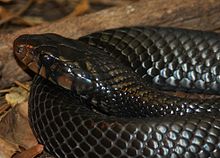Drymarchon
| Drymarchon | |
|---|---|
 |
|
| Drymarchon couperi, eastern indigo snake | |
| Scientific classification | |
| Kingdom: | Animalia |
| Phylum: | Chordata |
| Class: | Reptilia |
| Order: | Squamata |
| Suborder: | Serpentes |
| Family: | Colubridae |
| Subfamily: | Colubrinae |
| Genus: |
Drymarchon Fitzinger, 1843 |
| Species and subspecies | |
|
D. caudomaculatus |
|
| Synonyms | |
|
Coluber, Compsosoma, Georgia, Spilotes |
|
D. caudomaculatus
D. corais
D. couperi
D. melanurus
D. m. erebennus
Coluber, Compsosoma, Georgia, Spilotes
Drymarchon is a genus of large nonvenomous colubrid snakes, commonly known as indigo snakes, endemic to the Southeastern United States, Central America, and South America. Three to four species are currently recognized.
Indigo snakes are large, robust snakes which can reach a length of over 3 m (9.8 ft). They have smooth dorsal scales with several color variations, including a glossy blue-black color.
Indigo snakes are diurnal and actively forage for prey. They feed on a broad variety of small animals such as rodents, birds, lizards, frogs, toads, and other snakes, including rattlesnakes. They are not aggressive snakes and will only bite when threatened. Typical threat display includes hissing and shaking of its tail as a warning.
The genus Drymarchon was formerly considered to be a monotypic taxon formed by subspecies of D. corais. Currently the genus includes six distinct species recognized by ITIS:
...
Wikipedia
